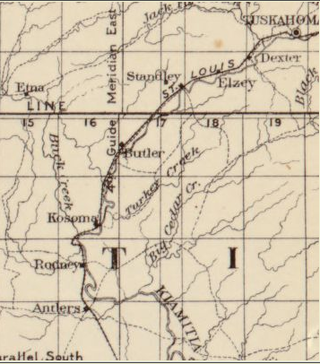Related Research Articles

Pushmataha County is a county in the southeastern part of the U.S. state of Oklahoma. As of the 2020 census, the population was 10,812. Its county seat is Antlers.

Antlers is a city in and the county seat of Pushmataha County, Oklahoma, United States. The population was 2,453 at the 2010 census, a 3.9 percent decline from 2,552 in 2000. The town was named for a kind of tree that becomes festooned with antlers shed by deer, and is taken as a sign of the location of a spring frequented by deer.
Rattan is a town in Pushmataha County, Oklahoma, United States. The population was 276 at the 2020 census.

The Kiamichi River is a river in southeastern Oklahoma, United States of America. A tributary of the Red River of the South, its headwaters rise on Pine Mountain in the Ouachita Mountains near the Arkansas border. From its source in Polk County, Arkansas, it flows approximately 177 miles (285 km) to its confluence with the Red River at Hugo, Oklahoma.
Moyers is an unincorporated community located in Pushmataha County, Oklahoma, United States.
Cloudy is an unincorporated community located in Pushmataha County, Oklahoma, United States. It is 12 miles northeast of Rattan. Cloudy is located at 34°18′07″N95°16′52″W.
Kosoma is a ghost town and former railroad station in Pushmataha County, Oklahoma, United States. It is located just off Oklahoma State Highway 2, approximately 10 miles (16 km) north of Antlers.
Kellond is an unincorporated community and former railroad station in Pushmataha County, Oklahoma, United States. Kellond is located approximately three miles northwest of Antlers on Oklahoma State Highway 2.
Rodney Mountain is located in Pushmataha County, Oklahoma, approximately five miles northwest of Antlers, Oklahoma. It is a part of the Kiamichi Mountains, a subrange of the Ouachita Mountains, and forms its southwest-most extremity. Its summit is 767 feet above sea level. It is found at GPS coordinates 34.2984336 and −95.6410833.
Corinne is an unincorporated community in southern Pushmataha County, Oklahoma, United States, located 19 miles east of Antlers. Using the Public Land Survey System commonly in use in Oklahoma, the community is located in T22-4S-R19E.
Dela is an unincorporated community in Pushmataha County, Oklahoma, United States, located six miles southeast of Antlers. It is within the jurisdiction of the Choctaw Nation of Oklahoma.
Dunbar is a community in Pushmataha County, Oklahoma, United States, 17 miles north of Antlers. Dunbar is located at 34°27′31″N95°33′38″W.
Miller is an unincorporated community in southwestern Pushmataha County, Oklahoma, United States, 10 miles northwest of Antlers and a short distance west of Moyers.

Rodney is a former community in Pushmataha County, Oklahoma, United States, five miles north of Antlers.
Sardis was a community in northern Pushmataha County, Oklahoma, United States, six miles northwest of Clayton.
Zoraya, pronounced “Zoray”, is a ghost town in western Pushmataha County, Oklahoma, United States, west of Miller.

Snow School is a historic school building in the rural community of Snow, Oklahoma, approximately 18 miles north of Antlers, Oklahoma. The school was added to the National Register of Historic Places in 1988.
Johns Valley is a geographic feature and place name located in the Kiamichi Mountains in northwestern Pushmataha County, Oklahoma. The valley] is formally classified by geologists as a “basin” due to its complete encirclement by mountains.
The Pushmataha County Historical Society is a historical society devoted to collecting and preserving the history of Pushmataha County, Oklahoma, United States. It is headquartered in the historic Frisco Depot in Antlers, Oklahoma, which it operates as a public museum.

The AT6 Monument is a granite memorial to Royal Air Force cadets who were killed while on a training flight during World War II. It stands on Big Mountain, north of Moyers, Oklahoma, in the United States, and was dedicated on February 20, 2000—the 57th anniversary of the deadly crashes.
References
- ↑ U.S. Geological Survey Geographic Names Information System: Jumbo, Oklahoma
- ↑ George H. Shirk, Oklahoma Place Names, p. 113; Post Office Site Location Reports, Record Group 28, National Archives.
- ↑ Morris, John W. Historical Atlas of Oklahoma (Norman: University of Oklahoma, 1986), plate 38.
- ↑ Antlers News, November 17, 1905.
- ↑ Antlers News, October 28, 1904.
- ↑ Antlers News, February 3, 1905.
- ↑ Antlers News, May 11, 1906.
- ↑ Antlers News, December 2, 1910.
- ↑ Recollection of Kay Brown Black, local resident.
